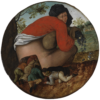Pieter Brueghel the Younger was born in Brussels around 1564/65 into an artistic dynasty.1 Grandson of Pieter Coecke van Aelst (1502–50) on his mother’s side, and son of Pieter Bruegel the Elder (1525/30–69), Pieter the Younger may have first trained with his maternal grandmother, Mayken Verhulst (1518–1600), who was a painter in her own right. His father had died when he was only five and, according to Karel van Mander, Verhulst taught Pieter the Younger’s younger brother, Jan Brueghel the Elder (1568–1625).2 Van Mander writes that Pieter the Younger studied with the Flemish landscape painter Gillis van Coninxloo (1544–1607), a training that likely occurred around 1580.3
By 1584/85 Pieter the Younger was registered as an independent master in the Guild of Saint Luke in Antwerp. He married Elizabeth Goddelet in 1588, and in that same year he took on his first of nine known apprentices, whose names include Frans Snyders (1579–1657) and Gonzales Cocques (1614–84).4 In 1589 Pieter and Elizabeth gave birth to a son, also named Pieter, who, following family tradition, became a painter, enrolling in the Antwerp guild in 1608. The date of Pieter the Younger’s death is not known, but his name appears in the list of death duties in the guild records in 1637/38, suggesting that he died at the age of seventy-three or seventy-four.
Pieter Brueghel the Younger, often referred to as “Peasant Brueghel,” largely depicted scenes of rural life. Assembling an enormous workshop, he produced numerous copies and adaptations of his father’s compositions, which varied in size, quality and, therefore, price. Pieter the Younger also painted scenes of his own invention, characterized, like his father’s work, by high viewpoints, sweeping vistas and crowds of figures attending marriages, fairs and country festivals. Despite the prolific production of his workshop, Pieter the Younger does not seem to have been enjoyed financial stability; his name appears time and again in municipal records detailing financial difficulties.5 Nevertheless, judging by the high number of his paintings in seventeenth-century inventories of Antwerp collections, as well as period export registries, his works—whether copies, imitations of original design, or by his large workshop—were extremely popular.6 He was, moreover, greatly admired by his peers, including Anthony van Dyck (1599–1641), who painted his portrait, and Peter Paul Rubens (1577–1640), who owned one of his works.
After Pieter’s death, his son Pieter III and his nephews Jan Brueghel the Younger (1601–78) and Ambrosius Brueghel (1617–75) carried on the family name. Anna Brueghel (1619–56), the sister of Jan and Ambrosius, married David Teniers the Younger (1610–90), further assuring the continuation of the great dynasty of Flemish painters.
